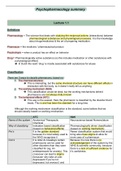Psychopharmacology summary
Lecture 1.1
Definitions
Pharmacology = The science that deals with studying the reciprocal actions (interactions) between
pharmacological substances and physiological processes. It is the knowledge
about drugs/medicines & the art of preparing medication.
Pharmacon = the medicine / pharmaceutical product
Psychotropic = when a product has an effect on behavior
Drug = Pharmacologically active substance (so this includes medication or other substances with
a physiological effect)
Classification
There are 3 ways to classify pharmacons, based on:
1. The chemical structure
This is interesting, but the same chemical structure can have different effects in
2. The working mechanism (NbN)
This classification would be ideal, but the working mechanisms behind
pharmacons are not always (fully) known
3. The behavioral effects (ATC)
This way is the easiest. Here the pharmacon is classified by the disorder that it
treats. This is and has been the standard for a long time.
Although the working mechanism classification is the standard, some believe that we
should classify based on working mechanism.
ATC NbN
Name of the system Anatomical Therapeutic Neuroscience-based Nomenclature
Chemical
Way of classifying Indication based classification Pharmacologically driven classification
(based on behavioral effects) (based on working mechanism)
It is the golden standard Newer classification system that would
bring about less stigma & allow for
the WHO recognizes it more uses of a pharmacon
It is older & nowadays certain Because it is new there is notHE
pharmacons can be used for acknowledgement of the system by the
other disorders than they were WHO & scientific community, because
classified for (eg. An there is a lack of sufficient evidence for
antidepressant for anxiety). This
crossover can lead to stigma
-
, can lower patient adherence to
the medicine.
Examples of the Antipsychotics Serotonin/Dopamine antagonists with
difference in naming antipsychotic actions
substances
Antidepressants Monoamine re-uptake inhibitors with
antidepressant action
Because ATC is most widely used, we study that.
ATC drug classes:
Antipsychotics
o Conventional antipsychotic (were discovered earlier, therefore conventional.
Can have large side effects)
o Atypical antipsychotic (were discovered later, therefore atypical, less side
effects)
Antidepressants
o Tricyclic
o Selective Serotonin re-uptake Inhibitors (SSRI)
o Monoamine Oxidase Inhibitors (MAOI)
Anxiolytics (anti-anxiety)
o Benzodiazepines
o Non-benzodiazepines (mood stabilizers)
o Lithium (hypnotics)
Anti-epileptics (against epileptic seizures)
o Benzodiazepines, Clonazepam, Clorazepaat
Stimulants
o Cocaine, Amphetamine (speed), Methylphenidate (ritalin), Caffeine, Nicotine
Narcotic pain killers
o Opioids, Morphine, Codeine, Heroin
Central Nervous System (CNS) suppressors
o Anesthesia
Psychedelics & Hallucinogens
o LSD, Marijuana, Hashish, Mescaline, Psilocybin
Administration of substances
The administration of substances includes 4 important stages:
1. Absorption = moving the substance from the site of administration to the bloodstream
2. Distribution = moving the substance throughout the body to the site of action
3. Metabolism = conversion of the substance by the body (active effect, breaking it down)
4. Excretion = elimination of the broken down substances
Absorption (stage 1) can happen in multiple ways:
Oral (swallowing)
o Easy to do, but the stomach acid eats away 2/3 of the medicine, keep only 1/3
Rectal
o Not so accessible, but here you only lose 1/3 and keep 2/3 of the medicine
Topical (focused on a specific site of the body)
o Skin
o Oral mucosa (in the mouth, uptake here is quicker bc there are lots of blood vessels)
Sublingual (under the tongue)
Buccal (between the teeth and the cheek)
, Advantage of oral mucosa is that you can spit the medicine out in case of an allergic
reaction
Parenteral (focused into a specific part of the body)
o Intravenous (in the veins, works quickly)
o Intramuscular (in the muscles, works a bit slower)
o Subcutaneously (under the skin eg. In the fat tissue)
Hard to reverse in case of an allergic reaction
Inhalation (to the lungs)
Distribution (stage 2) happens via the blood (albumin is the substance in the blood responsible for
the transport/distribution).
It can be distributed via:
Extracellular (into the blood plasma)
Intracellular (into the water in the body cells)
The speed o
through membranes to travel through the body. This process is a passive diffusion following the
concentration gradient.
Higher lipid solubility = faster crossing the membranes = faster distribution
For example: Heroin is 2-3x stronger than morphine because it has higher lipid solubility
Important processes: Pharmacokinetics & Pharmacodynamics
Pharmacokinetics
= How does the body process the medication? Concerns the change over time in
terms of serum concentration of the medication and the metabolites.
Has an effect on absorption, distribution, receptor interactions & elimination
Pharmacodynamics
= How does the body respond to the medication?
Medication & receptor interaction determines the pharmacological, therapeutic &
toxic effect.
, As you can see there is a time by concentration relationship.
First there is a large peak in the medication concentration in plasma because the
medication has just been administered
Then there is a large decrease in the medication concentration in the plasma because
the medication leaves the bloodstream & enters the body cells where it can have effect
Half-live = the time for the medication to halve in concentration (this can be from 100% to
50% but also 2% to 1%. All that matter is that is is halved)
1. Distribution half-live (alpha phase, pharmacokinetics)
= concerns the time needed for half of the medication to be absorbed
throughout the body (how much has left the bloodstream)
1st distribution half-live is most important = onset of action
2. Elimination half-live (beta phase, pharmacodynamics)
= concerns the time needed for half of the medication to be degraded by the
liver en excreted by the kidneys (how much has left the system)
6th elimination half-live is most important = stopping of action (98% gone)
Neurotransmission anatomy





